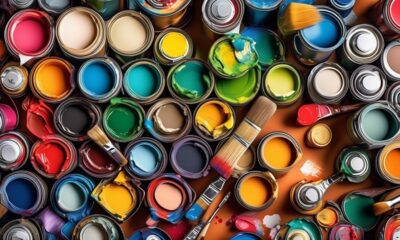Mardi Gras Decoration
Why Are Masks Required on Mardi Gras Floats?
2025
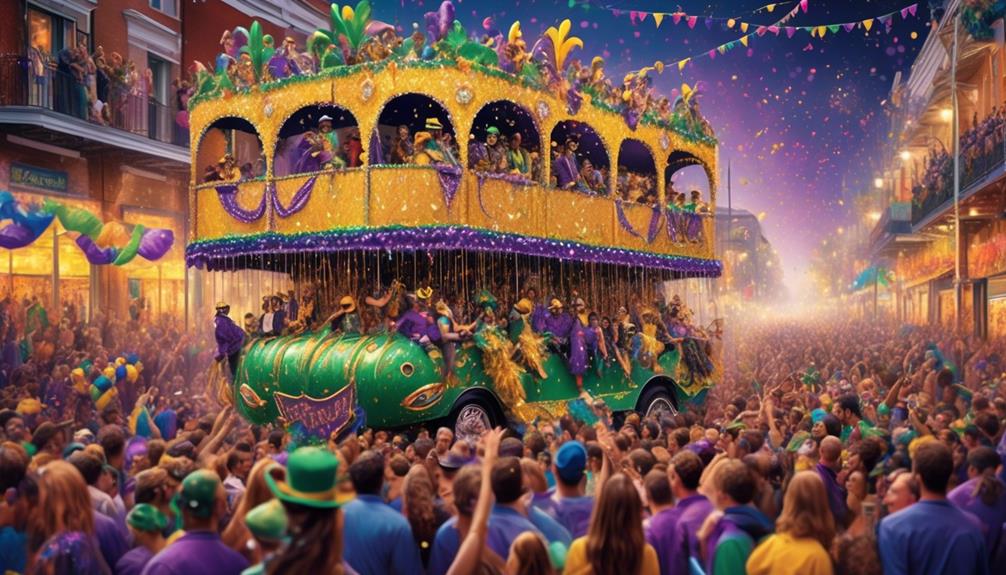
As we get ready to commemorate the vibrant and colorful celebrations of Mardi Gras, it’s fascinating to think about the seemingly contradictory necessity of masks on the elaborate floats that roll through the streets.
While we may associate Mardi Gras with exuberant revelry and flamboyant displays, the tradition of masks adds an enigmatic layer to the celebration. The significance behind this mandatory masking has deep historical roots and cultural implications that go beyond mere adornment.
It prompts us to question the role of anonymity and symbolism in this joyous spectacle, and perhaps even contemplate the deeper reasons behind this age-old tradition.
Key Takeaways
- Mardi Gras masks have historical roots dating back to ancient pagan rituals and were brought to the Americas by French and Spanish settlers.
- Mardi Gras masks symbolize anonymity, social equality, liberation, and unity during the festivities.
- Masks serve as a tradition of anonymity during Mardi Gras, allowing wearers to temporarily shed their societal roles and experience freedom of expression.
- Masks hold symbolic meanings in various cultures and historical periods, representing connections to ancestors, spirits, gods, and the celebration of life and death.
Origins of Mardi Gras Masks
The origins of Mardi Gras masks date back to ancient pagan rituals, where masks were worn to ward off evil spirits and bring good luck during the festive celebrations. Cultural origins of Mardi Gras masks can be traced to the European traditions of the 12th and 13th centuries when wearing masks during carnivals and festivals was a common practice. This tradition was later brought to the Americas by the French and Spanish settlers, evolving into the grand Mardi Gras celebrations we know today.
The symbolic significance of Mardi Gras masks is deeply rooted in the idea of anonymity and social equality. During early Mardi Gras celebrations, people from all walks of life would come together, and the wearing of masks allowed them to mingle without the constraints of societal class or identity. This sense of liberation and unity is still prevalent in modern Mardi Gras festivities, where people don intricate masks to partake in the revelry without the burden of social distinctions.
Mardi Gras masks continue to play a pivotal role in the cultural tapestry of the festival, embodying the rich history and traditions that have been passed down through generations.
Symbolism in Mardi Gras Masks

Originating from ancient pagan rituals, Mardi Gras masks hold deep symbolic significance in the festival's traditions. The symbolism and cultural significance of these masks are integral to the rich tapestry of Mardi Gras. Masks serve as a representation of anonymity, allowing wearers to temporarily shed their societal roles and embrace a sense of freedom during the festivities. They also symbolize a connection to historical roots, as they harken back to the early Mardi Gras celebrations where people wore masks to escape class constraints and social expectations.
To delve deeper into the symbolism of Mardi Gras masks, consider the following table:
| Symbolism | Cultural Significance |
|---|---|
| Anonymity | Allows for freedom and expression |
| Historical Roots | Connection to early celebrations |
| Transformation | Shedding societal roles temporarily |
| Celebration | Embracing joy and festivity |
This table illustrates the multifaceted symbolism and cultural significance of Mardi Gras masks, showcasing their role in fostering a sense of liberation and connection to tradition. The masks are not merely ornamental; they carry profound meaning that enriches the Mardi Gras experience.
Masked Identity and Anonymity
Wearing masks during Mardi Gras has a rich history that goes beyond mere ornamentation. The symbolism of masks encompasses aspects of concealment and the tradition of anonymity, which holds significant social implications.
Understanding the complexities of masked identity and the role of anonymity during Mardi Gras sheds light on the deeper cultural and historical significance of this tradition.
Symbolism of Masks
Exploring the symbolism of masks reveals the complex dynamics of masked identity and the power of anonymity in various cultural and historical contexts. Masks hold deep cultural significance across the globe, representing diverse meanings such as ritual, celebration, protection, and transformation. Below is a table that illustrates the symbolism of masks in different cultures and historical periods.
| Culture/Historical Period | Symbolism of Masks |
|---|---|
| African Tribal Rituals | Connection to ancestors, spirits, and nature |
| Venetian Masquerade Balls | Social equality behind anonymity |
| Japanese Noh Theater | Transformation into gods, spirits, and demons |
| Day of the Dead (Mexico) | Honoring the deceased and embracing mortality |
In each of these contexts, masks play a vital role in conveying symbolic meanings and cultural values, showcasing the intricate tapestry of human expression and tradition.
Tradition of Concealment
The tradition of concealment through masked identity and anonymity has been a recurring practice in various cultures and historical periods, serving multifaceted purposes beyond mere visual disguise.
In many societies, the concealment tradition holds deep cultural significance, often tied to rituals, ceremonies, and social events. Masks have been used to symbolize different facets of human existence, such as the duality of good and evil, the balance between life and death, and the interconnectedness of the natural and spiritual worlds.
Additionally, masked identity and anonymity allow individuals to transcend societal norms and express themselves freely without the constraints of their everyday personas. This tradition not only fosters a sense of community and belonging but also provides individuals with a platform to explore and embody alternative aspects of their identities.
Social Implications of Anonymity
As we shift our focus to the social implications of anonymity, it becomes evident that the tradition of concealment through masked identity and anonymity extends beyond cultural rituals to significantly impact communal dynamics and individual self-expression.
Anonymity and identity play a crucial role in the social psychology of masks. When individuals don masks, it can alter their behavior and interactions. The anonymity provided by masks can lead to increased confidence and uninhibited self-expression, allowing people to act outside their usual social boundaries. However, it also presents the potential for negative behaviors, as individuals may feel less accountable for their actions when their identity is concealed.
The dynamic interplay between anonymity and identity within social contexts is a complex phenomenon that continues to intrigue psychologists and sociologists, shaping our understanding of human behavior in communal settings.
Historical Evolution of Mask Tradition
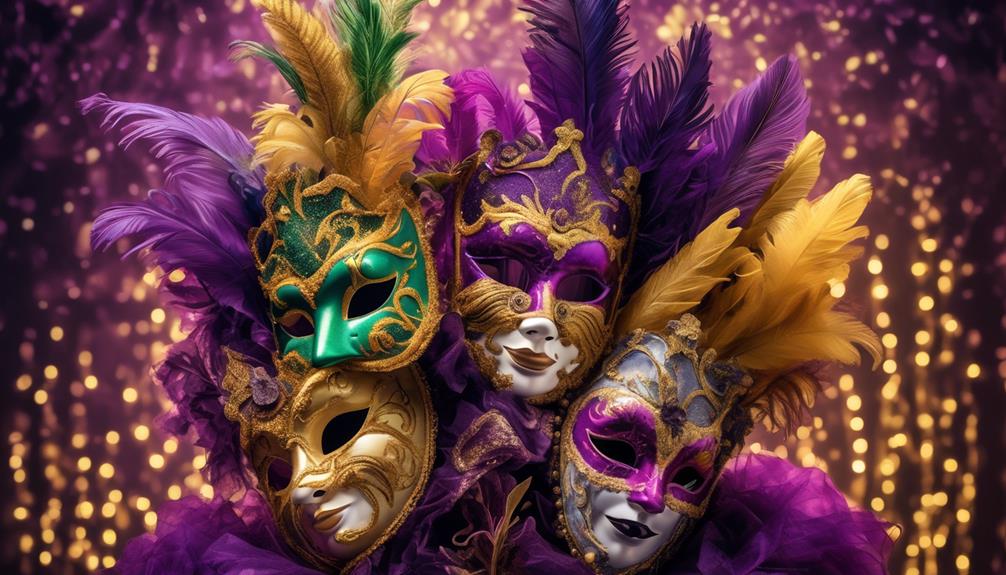
The historical evolution of mask tradition is a fascinating journey that spans centuries and continents.
From the ancient rituals of indigenous cultures to the opulent masquerade balls of European nobility, masks have held deep symbolic significance and served as a tool for secrecy and anonymity.
The evolution of mask-making techniques and styles reflects the changing social, cultural, and artistic landscapes of different societies.
Origins of Mask Tradition
Early accounts of mask-wearing trace back to ancient civilizations where they were used in religious rituals, celebrations, and theatrical performances. Cultural origins of mask traditions can be found in various parts of the world, including Africa, Asia, and Europe.
Masks were employed as a form of artistic expression, often representing deities, spirits, or ancestors. In many cultures, wearing a mask allowed individuals to embody different beings or convey specific emotions during ceremonies and festivities.
The use of masks also served practical purposes, such as protection from evil spirits or the concealment of one's identity. Over time, the tradition of mask-wearing evolved and adapted to different societal contexts, eventually becoming intertwined with various cultural practices and celebrations, including the vibrant and elaborate festivities of Mardi Gras.
Symbolism and Secrecy
The historical evolution of mask tradition intertwines various cultural practices and celebrations, including the vibrant and elaborate festivities of Mardi Gras, with symbolism and secrecy playing pivotal roles. Masks have been a symbol of secrecy and tradition in numerous cultures, holding cultural significance in rituals, celebrations, and performances. They serve as a visual representation of the wearer's connection to a particular tradition or belief system and are often used to convey societal roles and hierarchy. In the context of Mardi Gras, masks are emblematic of the celebration's roots in ancient pagan festivals where participants concealed their identities to escape societal constraints. The table below highlights the cultural significance and symbolism of masks in different traditions, showcasing their deep-rooted connection to secrecy and tradition.
| Tradition | Symbolism |
|---|---|
| Venetian Masquerade | Elegance, mystery, and anonymity |
| African Festivals | Connection to ancestors, spirits, and gods |
| Native American | Spiritual representation, transformation, and connection to nature |
| Chinese Opera | Depiction of character traits, emotions, and social status |
Evolution of Mask-Making
With the historical roots of mask-making spanning various cultures and time periods, the evolution of this tradition reflects a rich tapestry of artistic expression and cultural significance.
Artistic techniques have evolved over time, from the intricate carvings of African tribal masks to the delicate lacework of Venetian masquerade masks. Each culture has contributed unique methods of mask creation, from the vibrant feathered designs of indigenous peoples to the elaborate beadwork of Native American tribes.
Cultural influences have shaped the materials used, such as the use of natural elements like wood, clay, and feathers in traditional African masks, and the incorporation of luxurious fabrics and jewels in European masquerade masks.
The evolution of mask-making not only showcases the creativity of different societies but also highlights the interconnectedness of global artistic traditions.
Role of Masks in Mardi Gras Parades
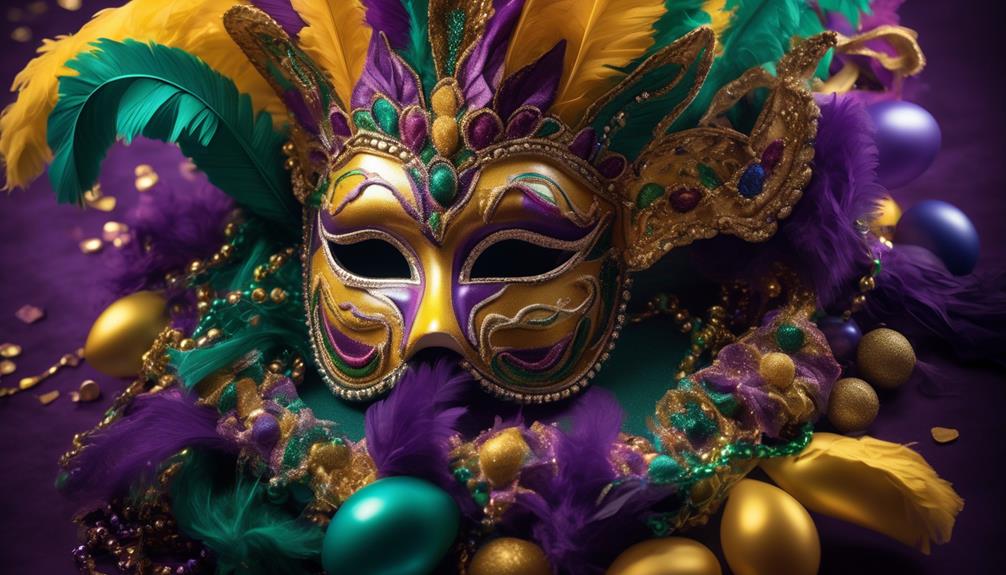
Masks play a crucial role in Mardi Gras parades, adding an air of mystery and excitement to the festivities. They hold deep cultural significance, symbolizing the traditions and history of Mardi Gras. The role of masks in these parades goes beyond mere concealment of identity; it's a form of artistic expression that allows individuals to embody different characters and personas, adding to the overall spectacle.
The symbolism of masks in Mardi Gras parades dates back to ancient rituals where masks were used to ward off evil spirits and bring good fortune to the community. Today, they serve as a means of celebrating the diversity of cultural influences that have shaped the Mardi Gras tradition. The intricate designs and vibrant colors of the masks further enhance the visual appeal of the parades, captivating the audience and creating an immersive experience.
In essence, masks aren't just accessories in Mardi Gras parades; they're integral components that encapsulate the rich history, cultural significance, and artistic expression of this vibrant celebration. Their role in the festivities is irreplaceable, adding depth and intrigue to the spectacle that's Mardi Gras.
Cultural Significance of Masked Revelry
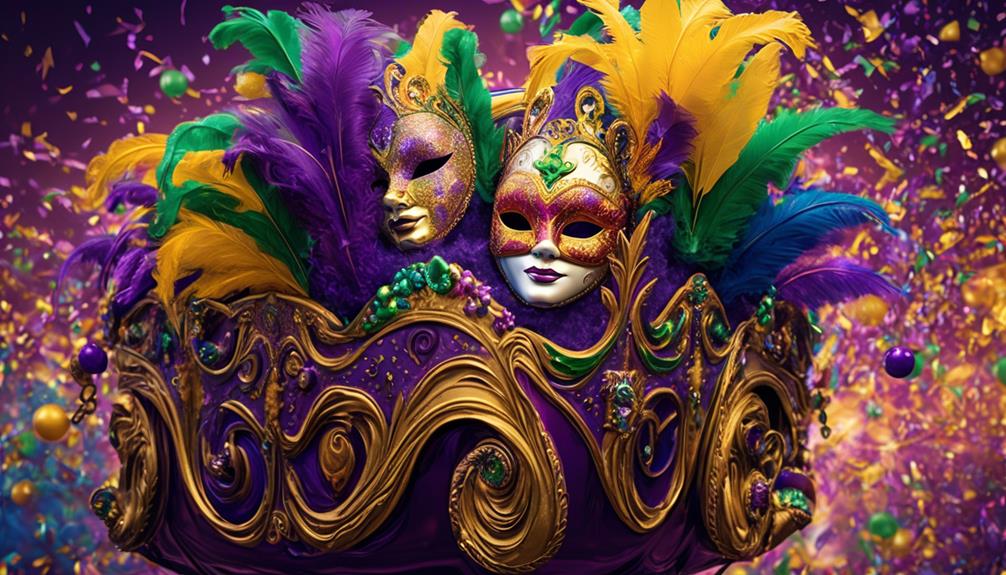
Masked revelry holds a deep cultural significance, rooted in the rich history of Mardi Gras and other traditional celebrations.
The act of wearing masks carries symbolic weight, often representing a sense of liberation, social anonymity, and the shedding of societal constraints.
This age-old tradition reflects the enduring importance of communal festivities and the expression of individual identity within a collective setting.
History of Masked Revelry
The tradition of concealing one's identity during festivities has deep cultural roots and significant historical importance.
Historical origins of masked revelry can be traced back to ancient civilizations such as the Greeks and Romans, where masks were used in ceremonies and celebrations.
In the Middle Ages, masked balls became popular among European nobility, providing a space for socializing and indulging in forbidden activities.
During the Renaissance, elaborate masquerade parties were held, allowing people to escape societal constraints.
The cultural significance of masked revelry lies in its ability to create a sense of mystery, freedom, and equality, as individuals from all walks of life can partake without judgment.
Masks also serve as a form of artistic expression, allowing wearers to embody different personas and explore their innermost desires.
Symbolism of Wearing Masks
During historical periods of masked revelry, individuals found a means to express themselves freely and escape societal norms through the symbolic act of wearing masks. The symbolism of wearing masks goes beyond mere concealment of one's identity. It carries cultural significance, allowing individuals to transcend social boundaries and assume alternate personas.
In many cultures, masked revelry represents a temporary reversal of social hierarchies, where individuals can briefly challenge authority and subvert traditional power dynamics. The act of donning a mask provides a sense of anonymity, enabling people to engage in activities that might otherwise be restricted by social conventions.
Additionally, masks serve as symbols of collective identity, fostering a sense of community and shared experience among participants. This cultural significance underscores the enduring appeal of masked revelry as a means of liberation and communal expression.
Social Anonymity and Liberation
Wearing masks during cultural celebrations allows individuals to experience a sense of social anonymity and liberation, enabling them to transcend societal norms and assume alternate personas. This social liberation has a profound psychological impact, offering a temporary escape from the constraints of everyday life and fostering a feeling of freedom and uninhibited self-expression.
- Embracing the unknown: Masks create an air of mystery and excitement, encouraging individuals to engage in behaviors they mightn't typically consider.
- Empowerment through transformation: Assuming a different identity through a mask can instill confidence and courage to explore new aspects of one's personality.
- Connection and unity: Shared anonymity can foster a sense of community and togetherness, breaking down social barriers and creating a space for genuine interaction.
These experiences contribute to the cultural significance of masked revelry, emphasizing the profound impact of social liberation and psychological empowerment.
Mask-Making and Artistic Expression
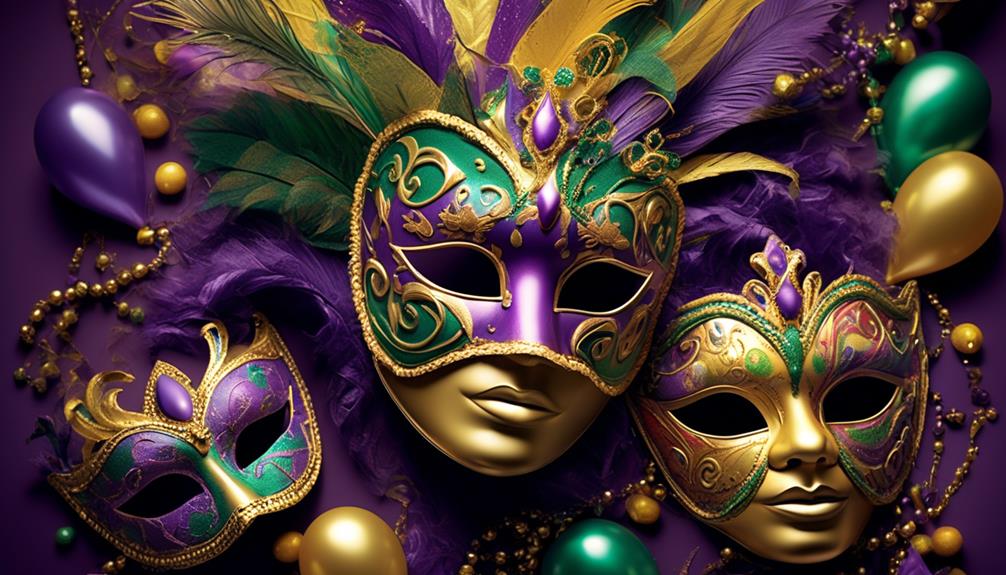
Creating intricate masks allows artisans to showcase their creativity and cultural heritage during Mardi Gras celebrations. The tradition of mask-making holds deep cultural significance, serving as a form of artistic expression that dates back centuries. Artisans use a variety of materials such as feathers, sequins, and vibrant fabrics to craft these stunning masks, each infused with symbolic meaning and regional influences.
Artistic expression through mask-making provides a platform for individuals to convey their personal stories and traditions. The designs often draw inspiration from historical events, mythology, and nature, reflecting the rich tapestry of cultural narratives embedded within Mardi Gras festivities. From the elaborate, feathered masks of the Venetian tradition to the brightly colored, bejeweled masks of the Caribbean, each style reflects the unique heritage of its creators.
Furthermore, the process of creating these masks fosters a sense of community and intergenerational bonding, as knowledge and techniques are passed down through families and local artisanal groups. As a result, the tradition of mask-making becomes a living testament to the resilience and creativity of diverse cultures, enriching the Mardi Gras experience with its depth and artistry.
Masks as Social Commentary
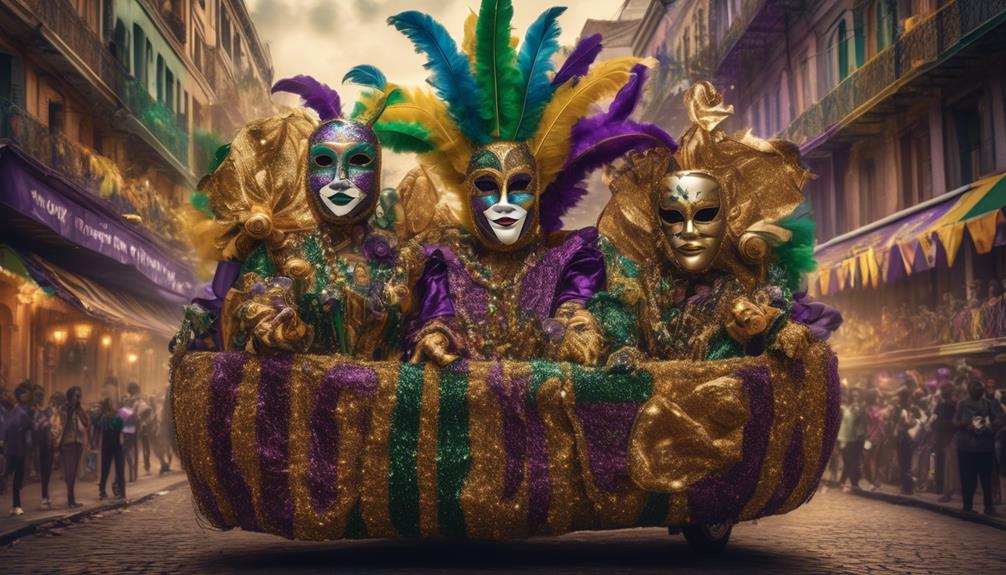
The tradition of mask-making not only serves as a form of artistic expression but also offers a platform for social commentary, reflecting the evolving cultural narratives embedded within Mardi Gras festivities. Masks, in their intricate designs and symbolism, convey powerful messages that resonate with the social and cultural significance of the time.
- Masks as Political Statements: These masks often portray political figures or carry symbols representing political ideologies, providing a means for individuals to express their views on governance and societal issues.
- Masks as Cultural Reflections: Through the use of traditional motifs and symbols, masks serve as a reflection of cultural identity and heritage, preserving and celebrating the diversity within the community.
- Masks as Calls for Change: Some masks are designed to challenge social norms, addressing issues such as inequality, discrimination, and justice, thus serving as a medium for advocating social change.
These masks, adorned with layers of meaning, offer a poignant commentary on the complexities of society, allowing individuals to engage with and respond to the cultural tapestry of the Mardi Gras tradition.
Masked Balls and Festive Gatherings
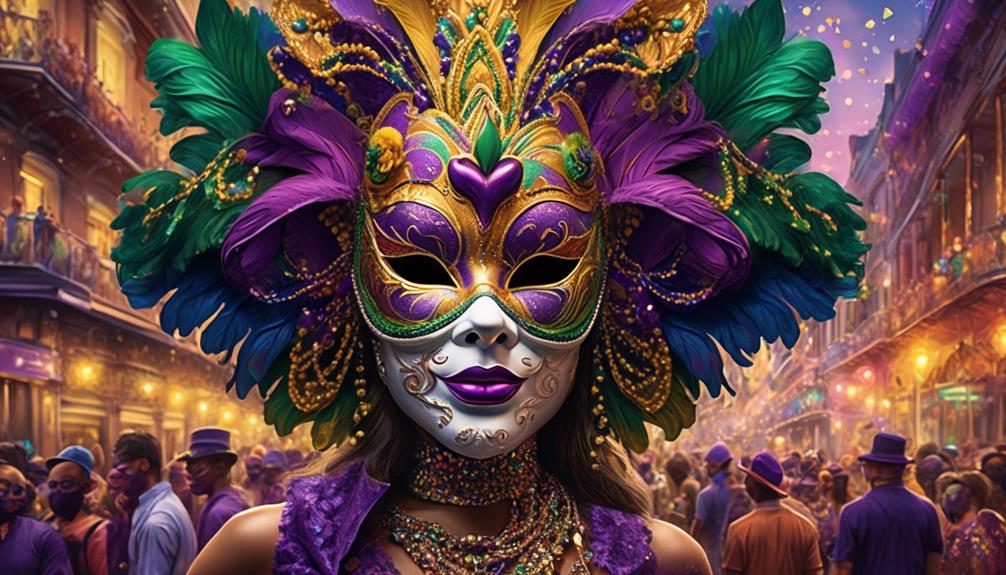
During the festive gatherings and masked balls of Mardi Gras, revelers don elaborate masks, adding an air of mystery and intrigue to the celebratory atmosphere. The tradition of masked balls dates back to medieval Europe, where they were a way for people of different social classes to mingle anonymously. Today, these events are a hallmark of Mardi Gras celebrations, with attendees donning intricate and ornate masks as part of their masked costume. These masks, often made of delicate materials such as lace, feathers, and beads, are carefully chosen to complement traditional attire, which may include elaborate gowns, tuxedos, and suits reminiscent of historical periods like the Renaissance or the Victorian era.
Masked balls and festive gatherings provide an opportunity for participants to embrace a sense of theatricality and escapism, immersing themselves in a world of fantasy and extravagance. The anonymity afforded by the masks allows individuals to shed their inhibitions and adopt alter egos for the duration of the event, creating an atmosphere of playful indulgence and flirtatious charm. The combination of masked costume and traditional attire adds an element of elegance and allure to these gatherings, making them a highlight of the Mardi Gras season.
Masked Tradition Across Cultures
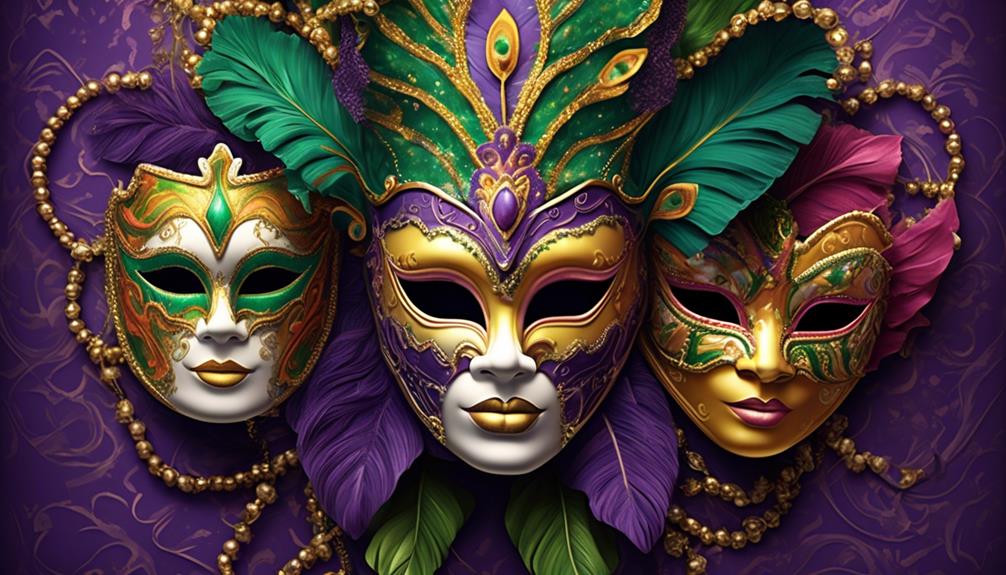
Masked balls and festive gatherings showcasing elaborate masks aren't unique to Mardi Gras but are part of a broader tradition found across various cultures worldwide. The wearing of masks has been a central feature of celebrations and cultural traditions for centuries.
Here are a few examples of the significance of masked celebrations in different cultures:
- Venetian Carnivals: The Venetian Carnival is famous for its masked balls and elaborate masks, dating back to the 13th century. Masks were worn to break down social barriers and allow people to mingle anonymously, creating a sense of equality and freedom.
- Mexican Day of the Dead: During the Day of the Dead celebrations, people wear intricately decorated skull masks to honor deceased loved ones. The masks serve as a way to connect with the spiritual realm and show reverence for the cycle of life and death.
- African Masquerade Festivals: Many African cultures have vibrant masquerade traditions where masks are worn to embody spirits, ancestors, or deities. These masked performances are integral to preserving cultural heritage and passing down traditional stories and values.
These examples demonstrate how masked celebrations hold deep cultural and historical significance, fostering a sense of unity, spirituality, and tradition within communities worldwide.
Psychological Impact of Masking
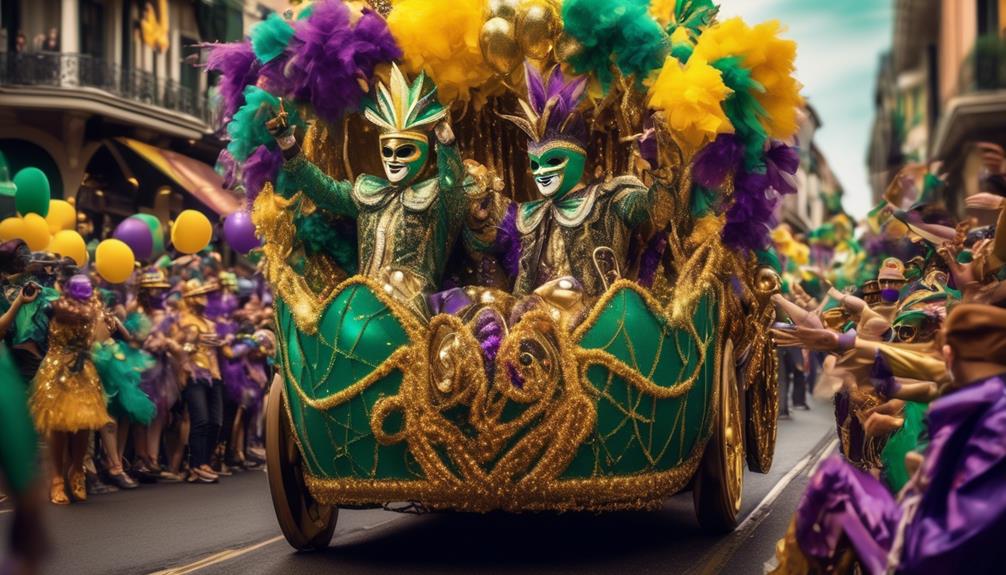
Understanding the psychological impact of wearing masks is crucial for comprehending their role in public health strategies and social interactions. Masks carry impactful symbolism and can have profound psychological effects on individuals and communities. Here is a table that outlines the psychological effects of masking:
| Psychological Effects | Description |
|---|---|
| Sense of Anonymity | Masks can create a sense of anonymity, allowing individuals to feel more comfortable expressing themselves |
| Reduced Inhibition | Wearing a mask can lead to reduced inhibition, encouraging individuals to engage in behaviors they might not otherwise |
| Increased Anxiety | Some individuals may experience increased anxiety when unable to read facial expressions and emotions |
| Symbolic Protection | Masks can symbolize protection, providing a sense of security and safety in uncertain or risky situations |
These psychological effects demonstrate the multifaceted impact of masks on individuals and society. By acknowledging the psychological implications of masking, we can better understand the complexities of human behavior and the interplay between personal well-being and public health measures.
Modern Interpretations of Masking
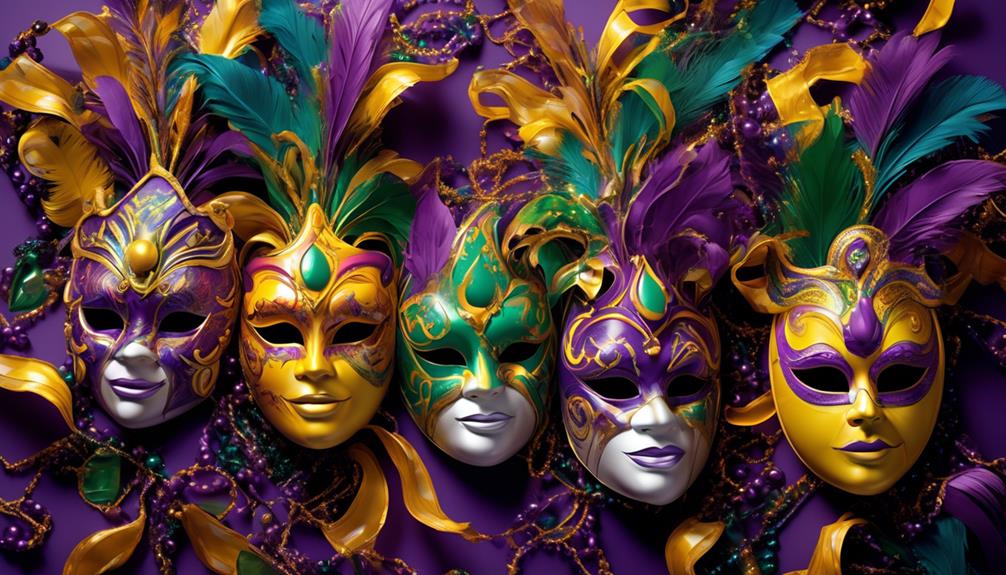
Modern interpretations of masking reveal evolving cultural and societal attitudes towards the use of face coverings. In today's society, the significance of masks has evolved beyond traditional purposes, reflecting the modern evolution of cultural values and psychological impact.
- Artistic Expression: Masks are now used as a form of artistic expression, showcasing individuality and creativity. This modern interpretation allows people to convey their emotions and thoughts through unique designs, colors, and patterns, reflecting the contemporary cultural significance of self-expression and identity.
- Health and Safety: The current interpretation of masking emphasizes the importance of public health and safety. Face coverings are now widely accepted as a preventive measure against the spread of infectious diseases. This shift reflects the modern evolution of societal responsibility and care for community well-being.
- Social Norms: The wearing of masks in various social settings has become a societal norm, influencing the dynamics of human interaction and communication. This modern interpretation demonstrates a shift in cultural norms and values, highlighting the psychological impact of adapting to new social behaviors.
These interpretations reflect the multifaceted and evolving role of masks in today's society, shaping cultural, social, and psychological landscapes.
Future of Masks in Mardi Gras Celebrations
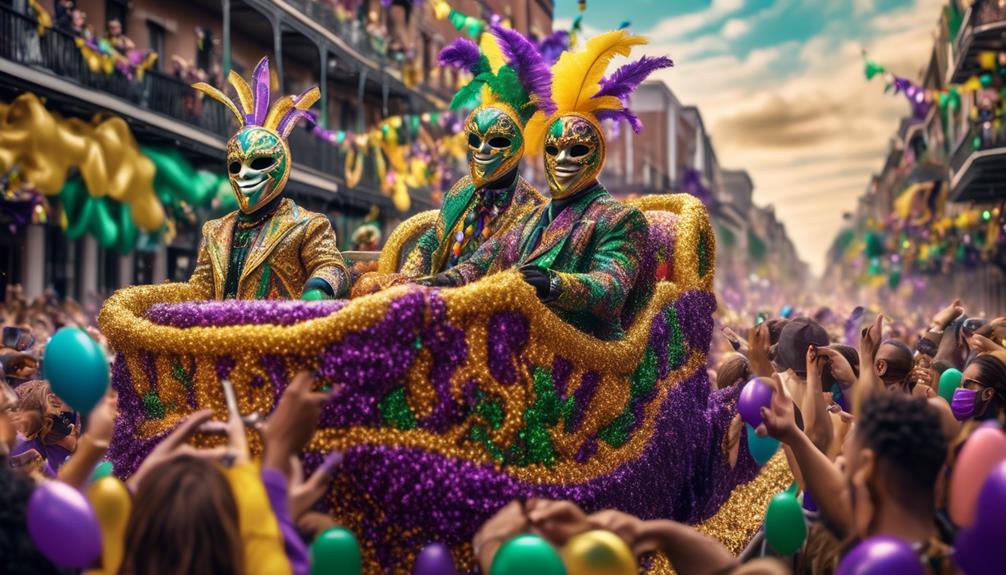
As we look ahead to the future of Mardi Gras celebrations, the role of masks is expected to continue evolving in response to changing cultural, social, and health considerations.
Cultural evolution plays a significant role in shaping the future of masks in Mardi Gras celebrations. The tradition of masking has deep roots in Mardi Gras, and as cultural dynamics shift, so too may the significance and style of masks. We anticipate that new artistic expressions and innovative designs will emerge, reflecting the evolving cultural landscape while maintaining the essence of the Mardi Gras tradition.
In light of public health concerns, the future of masks in Mardi Gras celebrations may also be influenced by ongoing efforts to ensure safety and well-being. The recent global health crisis has underscored the importance of public health measures, leading to a heightened awareness of the role masks play in limiting the spread of infectious diseases. As a result, we may see an increased emphasis on incorporating health-conscious elements into the design and use of Mardi Gras masks, ensuring that they not only preserve tradition but also contribute to the safety of participants and spectators.
Frequently Asked Questions
How Often Are Masks Required on Mardi Gras Floats?
Masks are integral to Mardi Gras floats, emphasizing their cultural significance. The frequency of mask requirements varies by parade and organization. They're a symbol of mystery and tradition, adding to the festive atmosphere.
Masks allow riders to maintain their anonymity, contributing to the mystique of the celebration. They're also a nod to the historical origins of the event.
Are There Any Specific Rules or Guidelines for the Design of Masks on Mardi Gras Floats?
Are there specific rules for mask design on Mardi Gras floats?
Mask design is crucial to Mardi Gras, reflecting cultural significance and creativity. While guidelines vary, masks often feature vibrant colors, intricate patterns, and symbolic elements. They're designed to evoke mystery, tradition, and celebration.
The rules may include size restrictions for visibility, but the overall emphasis is on embracing the vibrant spirit of Mardi Gras through expressive and culturally significant mask design.
Do Different Mardi Gras Krewes Have Different Requirements for Masks on Their Floats?
Different krewes often have distinct requirements for masks on their floats. Each krewe may have different themes, leading to varied expectations for mask designs. Some krewes prefer traditional masks, while others embrace more modern and elaborate designs.
These differences in preferences contribute to the diverse and vibrant displays seen during Mardi Gras celebrations.
Are There Any Exceptions or Special Circumstances Where Masks Are Not Required on Mardi Gras Floats?
Exceptions to the mask requirement on Mardi Gras floats are rare, but enforcement can vary.
Special circumstances, like performers needing unobstructed views or medical conditions, may warrant exceptions.
Compliance is generally high, with krewes and officials emphasizing safety.
However, it's essential to follow specific guidelines to ensure everyone's enjoyment and safety during the festivities. This includes being mindful of the event’s venue policies, respecting personal boundaries, and adhering to any set decor restrictions. For instance, familiarizing yourself with the rules for table centerpieces can help avoid potential hazards, such as obstructing views or causing fire risks. By paying attention to these details, you contribute to a smoother, more enjoyable celebration for all participants.
How Do Organizers Enforce the Mask Requirement on Mardi Gras Floats?
Enforcement methods for the mask requirement on Mardi Gras floats include organizers monitoring compliance and providing masks if needed.
The mask mandate honors the cultural significance of Mardi Gras, promoting anonymity and equality.
Organizers emphasize the tradition's importance while ensuring safety.
This approach fosters a sense of community and respect for the celebration's roots.
Conclusion
In conclusion, the tradition of wearing masks during Mardi Gras parades has deep roots in history and symbolism.
From its origins as a way to escape social constraints to its role in preserving anonymity and creating a sense of mystery, masks have played a significant role in the celebration.
As we look to the future, it's clear that the tradition of wearing masks will continue to be a vital and cherished aspect of Mardi Gras celebrations, keeping alive an ancient anachronism in modern times.
- About the Author
- Latest Posts
Introducing Ron, the home decor aficionado at ByRetreat, whose passion for creating beautiful and inviting spaces is at the heart of his work. With his deep knowledge of home decor and his innate sense of style, Ron brings a wealth of expertise and a keen eye for detail to the ByRetreat team.
Ron’s love for home decor goes beyond aesthetics; he understands that our surroundings play a significant role in our overall well-being and productivity. With this in mind, Ron is dedicated to transforming remote workspaces into havens of comfort, functionality, and beauty.
Mardi Gras Decoration
Mardi Gras Decor Ideas: Bringing New Orleans Flair to Your Home
Get inspired with vibrant Mardi Gras decor ideas to transform your home into a festive New Orleans celebration that your guests won’t forget!

To bring the vibrant flair of New Orleans Mardi Gras into your home, embrace bold colors like purple, green, and gold. Add festive elements like masks, beads, and king cake to create an authentic atmosphere. Use a crisp white tablecloth to highlight colorful dishes and DIY decorations, like painted glassware or custom banners. Engage your guests with a themed coffee bar and vibrant centerpieces. Don't forget to design your space for conversation and fun. With these ideas, your Mardi Gras celebration will be unforgettable. Explore more creative tips to enhance your festive ambiance further!
Key Takeaways
- Embrace bold colors like purple, green, and gold to capture the essence of Mardi Gras and create a festive atmosphere.
- Incorporate traditional elements such as masks, beads, and king cake to enhance authenticity and celebrate New Orleans culture.
- Use a crisp white tablecloth as a backdrop to make vibrant decorations pop for an eye-catching table setting.
- Engage in DIY projects, like painting glassware and creating bead curtains, to add a personal touch to your decor.
Celebrate With Bold Colors
To truly celebrate Mardi Gras, you should embrace bold colors like purple, green, and gold, which capture the essence of this vibrant festival.
These bright colors not only symbolize justice, faith, and power, but they also bring an energetic flair to your home. Start with simple decorating ideas that incorporate these hues in your interior design. You might love to see table settings adorned with vibrant napkins and centerpieces that reflect the spirit of Mardi Gras.
Consider DIY projects that are budget friendly, like painting glassware in these festive colors or creating custom banners.
Adding colorful masks and beads as decorative accents can also enhance the festive theme, evoking the excitement of Mardi Gras parades right in your living space.
Don't overlook the power of floral arrangements; choose seasonal blooms in bold hues to serve as focal points in your home.
With these decorating ideas, you'll create a lively atmosphere that truly celebrates the spirit of Mardi Gras, inviting friends and family to join in the fun.
Essential Mardi Gras Elements

What essential elements should you include to create an authentic Mardi Gras celebration?
Start with a crisp white tablecloth as your base to enhance the vibrant colors of your decor. Incorporate classic Mardi Gras elements like king cake, masks, and beads, which capture the spirit of this festive occasion. Use simple white dishes for versatility and consider personalizing them with DIY plate decorations using glass paint markers.
To elevate your dining experience, add vintage candleholders and colorful drip candles, creating a warm and inviting ambiance. Gold napkins paired with Mardi Gras beads as decorative napkin rings will bring a touch of elegance to your table setting.
Don't forget about the festive beverages! Serve kids Abita Root Beer while adults can enjoy traditional offerings like Café Du Monde coffee and beignets.
These essential components won't only enhance the overall look of your Mardi Gras celebration but also immerse your guests in the rich cultural heritage of New Orleans. By including these elements, you'll create a lively atmosphere that captures the joy and excitement of Mardi Gras.
DIY Decor Projects

Enhancing your Mardi Gras celebration can be as simple as incorporating fun DIY decor projects that reflect the festive spirit of the occasion. These projects not only add a vibrant touch to your home but also create a warm and inviting atmosphere for your guests.
Here are some easy DIY decor ideas to get you started:
- Festive Bead Curtains: Create a curtain using strands of beads from Dollar Tree for just $3. This eye-catching display works great for entryways or windows.
- Themed Coffee Bar Sign: Paint a six-inch canvas with fun designs and add voodoo doll stitches for a unique sign that brings a playful touch to your coffee bar.
Tips for Hosting Parties
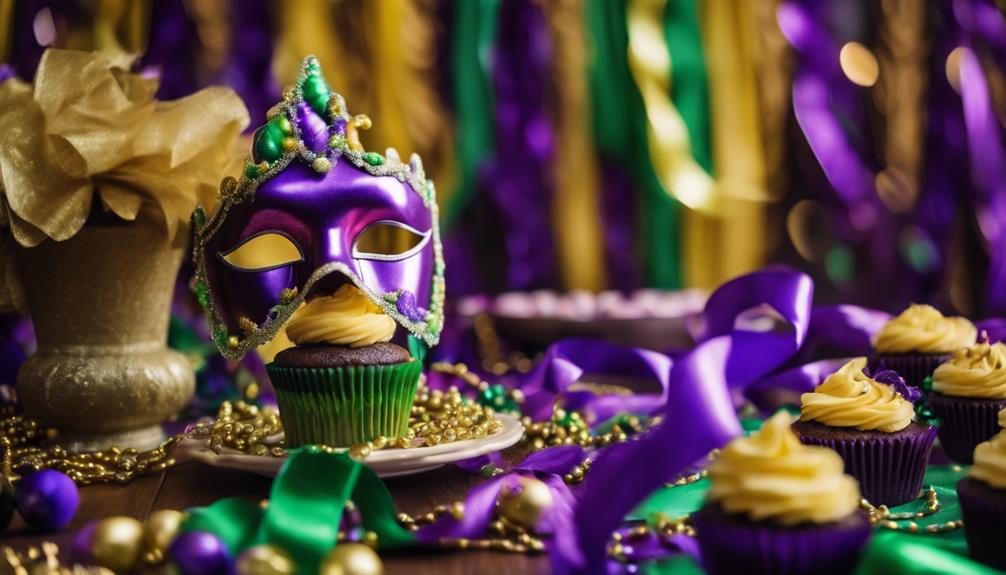
Hosting a memorable Mardi Gras party starts with a thoughtful layout that encourages conversation and keeps guests engaged. Assess your space and arrange furniture to create a welcoming atmosphere. Consider how guests will flow through the area, ensuring accessibility while mingling.
Use bold colors and festive decorations, like masks and beads, to enhance the celebratory spirit of your gathering. Think about incorporating multifunctional spaces—set up areas for dining, socializing, and entertainment. This allows guests to enjoy varied activities throughout the party.
To achieve cohesive decor, utilize themed elements such as a king cake centerpiece and vintage candleholders adorned with colorful candles. These details tie the room together and create a festive vibe.
As you're hosting parties, take note of how guests interact with your space. This can reveal areas for improvement, helping you make adjustments for future gatherings.
Incorporating Personal Style

Personalizing your Mardi Gras decor not only reflects your unique style but also makes your celebration feel more intimate and special. By showcasing unique treasures, like heirlooms and colorful pieces, you can weave your history into the festivities. Embrace bold colors—purple, green, and gold—to create lively spaces that resonate with your love for the holiday.
Here are some ideas to incorporate your personal taste:
- Use simple white dishes as a versatile base, allowing you to customize with themed elements like masks and beads.
- Engage in DIY projects such as painting personalized plates or crafting themed signs to add character and authenticity to your decor.
Frequently Asked Questions
When Should I Start Decorating for Mardi Gras?
You should start decorating for Mardi Gras at least a week before the event. This way, you'll have plenty of time to gather supplies and create vibrant displays that capture the festive spirit.
How Do You Have a Mardi Gras Party at Home?
To host a Mardi Gras party at home, you'll need vibrant colors, festive foods, lively music, and engaging activities. Set the scene, serve traditional dishes, and encourage creativity to create an unforgettable celebration.
How Do You Decorate for Mardi Gras?
To decorate for Mardi Gras, use vibrant colors like purple, green, and gold. Incorporate masks, beads, and themed vignettes. Consider DIY projects to personalize your space, adding vintage candleholders for an elegant, festive touch.
Conclusion
As you deck your home in vibrant purples, greens, and golds, it's funny how a celebration rooted in joy can remind you of life's chaos.
You might think you're just hanging beads and masks, but in reality, you're weaving a tapestry of memories, laughter, and community.
So, whether you're hosting a grand party or enjoying a quiet moment, remember: it's the spirit of Mardi Gras that transforms your space, turning your home into a joyous escape. With a blend of vibrant decorations and personal touches, you can create an ambiance that embodies both festivity and comfort. Incorporate the ultimate relaxing sanctuary tips by layering soft lighting, cozy seating areas, and soothing scents to balance the lively energy of the celebration. This way, your home becomes a perfect fusion of exuberance and tranquility, making the Mardi Gras experience truly unforgettable.
- About the Author
- Latest Posts
Introducing Ron, the home decor aficionado at ByRetreat, whose passion for creating beautiful and inviting spaces is at the heart of his work. With his deep knowledge of home decor and his innate sense of style, Ron brings a wealth of expertise and a keen eye for detail to the ByRetreat team.
Ron’s love for home decor goes beyond aesthetics; he understands that our surroundings play a significant role in our overall well-being and productivity. With this in mind, Ron is dedicated to transforming remote workspaces into havens of comfort, functionality, and beauty.

Some people may argue that Mardi Gras is just a festival of partying and extravagance, completely disconnected from any religious meaning. Nevertheless, when delving into the historical origins and cultural customs of this yearly event, it becomes clear that Mardi Gras has strong ties to religious symbolism and practices. Historically, Mardi Gras traces its roots back to Christian traditions, particularly the period of feasting and celebration before the solemn season of Lent. The colors, parades, and festivities often symbolize deeper themes of repentance, indulgence, and preparation for spiritual reflection. In this way, a modern Mardi Gras party explained through its origins reveals a blending of sacred and secular traditions that continue to shape its celebratory nature.
From its origins as a Christian feast day to its connections with the Lenten season and spiritual practices, Mardi Gras holds a significant religious significance. But how exactly did this festive event become associated with religious observances?
Stay tuned as we uncover the religious underpinnings of Mardi Gras and its relevance in modern-day celebrations.
Key Takeaways
- Mardi Gras has pagan roots and was incorporated into the Christian liturgical calendar.
- The colors of Mardi Gras (purple, green, and gold) have Christian symbolism.
- Mardi Gras marks the beginning of the Christian liturgical season of fasting and reflection.
- Masks, throws, and king cakes all have religious symbolism in Mardi Gras celebrations.
Origins of Mardi Gras
The origins of Mardi Gras date back to ancient pagan celebrations and were later incorporated into Christian traditions. Mardi Gras, French for 'Fat Tuesday,' has deep pagan roots, originally linked to Roman and Greek festivals celebrating the arrival of spring and fertility. These pagan festivities were eventually adapted by the Christian church as a way to incorporate and reframe these cultural celebrations within the context of Christian beliefs.
Over time, the carnival-like atmosphere and traditions of Mardi Gras became intertwined with the Christian liturgical calendar, specifically the period of feasting and celebration before the solemnity of Lent.
The cultural significance of Mardi Gras lies in its ability to bring people together in joyous celebration before the introspective and penitent season of Lent. It has become a time for communities to come together, feast, and revel in the richness of life before a period of sacrifice and reflection. This celebration reflects the deep human need for both communal joy and personal growth, making Mardi Gras a holiday with profound spiritual and cultural significance. The Mardi Gras celebration purpose extends beyond mere festivity; it serves as a bridge connecting the sacred and the secular, allowing individuals to embrace both joy and reverence. Through vibrant parades, music, and shared traditions, it reinforces a sense of belonging and cultural identity within diverse communities. Ultimately, Mardi Gras reminds us of the balance between indulgence and discipline, highlighting the cyclical nature of human experiences.
Christian Traditions and Symbolism

Christian traditions and symbolism play a significant role in the evolution and observance of Mardi Gras. The colors of Mardi Gras, purple, green, and gold, are steeped in Christian symbolism. Purple symbolizes justice, green represents faith, and gold signifies power. These colors reflect the religious significance of Mardi Gras, reminding us of our Christian values and calling us to live out these virtues.
The practice of consuming rich and indulgent foods before the fasting period of Lent also holds religious connotations. This tradition, known as 'Fat Tuesday,' encourages us to reflect on the upcoming period of self-discipline and spiritual growth. It serves as a reminder of Christ's sacrifice and the importance of repentance and inner renewal.
Furthermore, Mardi Gras is deeply tied to Christian traditions through its association with the liturgical calendar. The observance of Ash Wednesday, which marks the beginning of Lent, is intrinsically linked to the revelry of Mardi Gras. This juxtaposition of celebration and solemnity underscores the profound religious significance of Mardi Gras within the Christian faith.
Relationship With the Lenten Season
As believers, we closely connect Mardi Gras with the upcoming Lenten season, a period of reflection and spiritual growth. Mardi Gras, also known as Fat Tuesday, falls just before Ash Wednesday, which marks the beginning of Lent. This connection is deeply rooted in Catholic tradition, where Mardi Gras serves as a final celebration before the solemn and reflective season of Lent. It's a time for us to prepare our hearts and minds for the Lenten journey ahead, where we focus on prayer, fasting, and almsgiving.
Lenten preparation starts with the joyous festivities of Mardi Gras, reminding us of the upcoming season's call to serve others with humility and compassion. As we engage in the revelry of Mardi Gras, we're also mindful of the need to embark on a period of self-examination and spiritual discipline during Lent. This dual experience reinforces the connection between the two, reminding us of the importance of balancing celebration with introspection and service.
Our relationship with the Lenten season isn't just about personal reflection but also about how we can better serve those around us. This connection between Mardi Gras and Lent deepens our understanding of the call to love and serve others, making the transition from celebration to spiritual growth seamless and purposeful.
Religious Observances and Practices

In our religious observances and practices, we engage in acts of devotion and service that deepen our spiritual connection and foster a sense of community. These practices are essential for nurturing our faith and strengthening our bond with each other.
Here are some key aspects of our religious observances and practices:
- Prayer Rituals
- We believe in the power of prayer to seek guidance, express gratitude, and offer intercession for others.
- Through regular prayer rituals, we cultivate a deeper connection with the divine and find solace in times of need.
- Service to Others
- Serving others is integral to our religious beliefs, and we actively seek opportunities to extend compassion and support to those in need.
- By engaging in acts of service, we emulate the values of our faith and contribute to the well-being of our community.
- Religious Festivals
- Religious festivals hold great significance in our spiritual journey, providing opportunities for communal worship, reflection, and celebration.
- These festivals offer a chance for us to come together as a community, reaffirm our shared beliefs, and find inspiration in the collective expression of faith.
Our religious observances and practices are a testament to our commitment to serving others and nurturing our spiritual connection through prayer rituals and participation in religious festivals.
Spiritual Significance in Modern Celebrations
Amidst the vibrant festivities of modern celebrations, we find a deep and enduring spiritual significance that unites us in shared reverence and reflection.
In today's Mardi Gras, the spiritual aspect has evolved to encompass a broader, more inclusive understanding. Modern interpretations of Mardi Gras emphasize the cultural significance of coming together as a community to celebrate life, joy, and resilience.
It's a time when people seek to uplift one another, embodying the values of compassion, kindness, and charity. This spiritual underpinning is evident in the various community service initiatives that have become integral to Mardi Gras celebrations.
From volunteering at local shelters to organizing food drives, there's a growing emphasis on using this festive occasion as an opportunity to serve and support those in need.
In this way, Mardi Gras has become not only a time of revelry but also a period of meaningful connection and service to others, reflecting the enduring spiritual significance that continues to shape modern celebrations.
Frequently Asked Questions
How Do Non-Christian Religions and Cultures Celebrate Mardi Gras?
We celebrate Mardi Gras with non-Christian celebrations and cultural influences. People of various faiths and backgrounds come together to participate in the festivities.
Non-Christian traditions such as parades, mask-wearing, and indulging in rich foods are integrated into the celebrations.
Cultural influences from different regions and ethnicities add vibrant and diverse elements to the Mardi Gras festivities, creating a unique and inclusive experience for everyone involved.
What Is the Role of Mardi Gras in the History of Religious Persecution and Tolerance?
Mardi Gras has a significant role in the history of religious tolerance and has been tied to historical persecution. The celebration represents a time of religious freedom and acceptance, where diverse cultures come together in unity.
The festivities reflect the resilience of communities in the face of religious adversity. Through the ages, Mardi Gras has stood as a symbol of religious tolerance and the triumph of the human spirit over oppression.
How Do Different Christian Denominations Interpret the Religious Significance of Mardi Gras?
Different Christian denominations interpret the religious significance of Mardi Gras differently. These interpretation differences stem from varying theological beliefs and historical traditions.
The religious significance celebrations can range from solemn reflections on the upcoming Lenten season to joyous celebrations of the last moments before the fasting period.
Understanding these differences allows us to appreciate the diverse ways in which different denominations honor this important religious holiday.
Are There Any Specific Prayers or Rituals Associated With Mardi Gras in Religious Observances?
Prayer traditions and ritual practices are integral to religious observances of Mardi Gras. Many denominations hold special prayer services and engage in symbolic rituals as part of their Mardi Gras celebrations. These can include praying for forgiveness, participating in processions, and observing fasting and abstinence.
These practices are intended to prepare for the solemn season of Lent and reflect on the spiritual significance of Mardi Gras.
How Have Modern Interpretations of Spirituality and Mindfulness Influenced the Way Mardi Gras Is Celebrated in Religious Communities?
Modern interpretations of spirituality and secular influence have shaped the way Mardi Gras is celebrated in religious communities.
Spiritual mindfulness has led to a greater emphasis on reflection and serving others during this cultural celebration.
In some religious observances, Mardi Gras has evolved to incorporate elements of community service and outreach, reflecting a deeper connection to the principles of faith and compassion in the modern context.
Conclusion
In conclusion, Mardi Gras is a religious holiday rooted in rich traditions and symbolism. Its origins and observances are deeply tied to the Christian faith, particularly in preparation for the Lenten season.
The spiritual significance of Mardi Gras is still evident in modern celebrations, showcasing the enduring connection between faith and festivity.
So let's remember the religious roots and revel in the spiritual significance of this colorful and vibrant holiday!
- About the Author
- Latest Posts
Introducing Ron, the home decor aficionado at ByRetreat, whose passion for creating beautiful and inviting spaces is at the heart of his work. With his deep knowledge of home decor and his innate sense of style, Ron brings a wealth of expertise and a keen eye for detail to the ByRetreat team.
Ron’s love for home decor goes beyond aesthetics; he understands that our surroundings play a significant role in our overall well-being and productivity. With this in mind, Ron is dedicated to transforming remote workspaces into havens of comfort, functionality, and beauty.
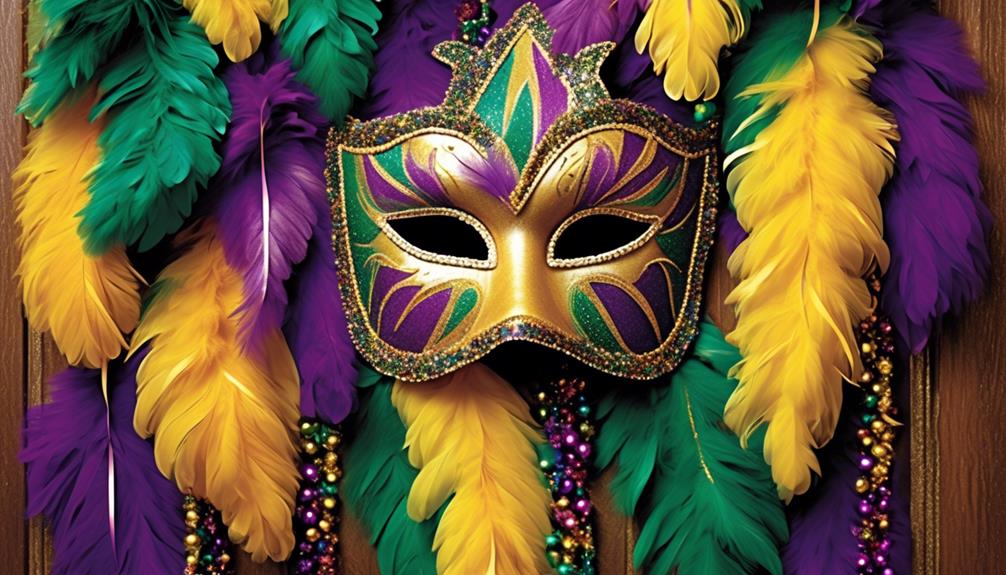
When it comes to decorating for Mardi Gras, we often struggle to find a balance between making a memorable impact and sticking to a budget. The key is to blend boldness and elegance, creating a festive atmosphere that embodies the essence of the holiday without being too overwhelming.
With a few simple yet creative ideas, you can transform any space into a festive Mardi Gras wonderland that will have everyone feeling the festive spirit.
Key Takeaways
- Mardi Gras decorations can include masks, jester hats, bead garlands, feather boas, and glittery table centerpieces.
- Masks can be painted with bold patterns and designs using acrylic paints and glitter.
- Jester hats can be created using colorful cardstock, glitter, bells, and elastic bands.
- Bead garlands can be used to decorate parade floats or create a festive atmosphere, and can also be used to create bead bracelets, necklaces, belts, and headpieces.
Colorful Mardi Gras Masks
Let's get ready to create vibrant and eye-catching Mardi Gras masks that will add a burst of color and excitement to our decorations. Mask painting is a delightful activity that allows us to express our creativity and add a personal touch to the festive ambiance.
To start, gather a variety of plain masks, acrylic paints, paintbrushes, glitter, feathers, and other embellishments. Begin by brainstorming designs and color schemes. Once you have a plan in mind, use the paint to create bold patterns, intricate designs, or even abstract art on the masks. Experiment with different brush strokes and techniques to achieve the desired effect.
Don't forget to let each layer of paint dry before adding new elements to avoid smudging or blending colors unintentionally. As the base design takes shape, explore mask decorating techniques such as adding glitter for a touch of sparkle or attaching feathers to create a dramatic effect.
These masks won't only enhance our decorations but also bring joy to those who see them. Let's share this creative experience with others and spread the vibrant spirit of Mardi Gras!
Festive Bead Garlands
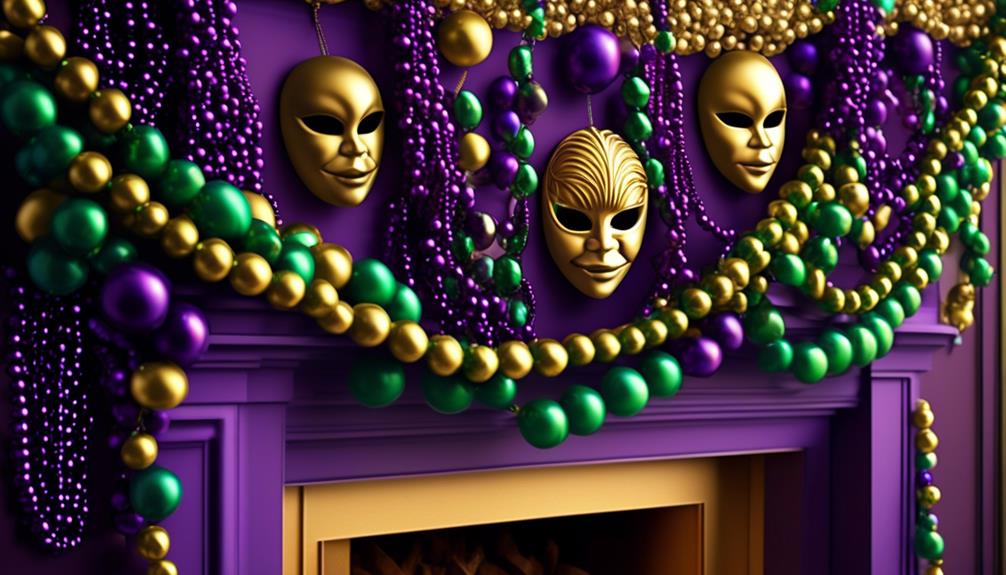
After creating our colorful Mardi Gras masks, we are now ready to dive into the world of festive bead garlands, adding a touch of elegance and flair to our decorations. Bead crafting techniques can elevate the ambiance of any Mardi Gras celebration. To assist you in this endeavor, we've compiled a selection of DIY costume accessories and parade float decorations that will surely delight your guests and spectators.
| Bead Crafting Techniques | Party Favor Ideas | DIY Costume Accessories | Parade Float Decorations |
|---|---|---|---|
| Stringing beads to create stunning garlands | Giving away homemade bead bracelets as party favors | Crafting bead necklaces, belts, and headpieces | Using bead garlands to adorn parade floats and create a festive atmosphere |
Vibrant Feather Boas
Let's talk about the vibrant feather boas!
When it comes to Mardi Gras decorations, feather boas are a must-have.
We'll explore the wide array of feather boa colors, embellishments, and creative hanging ideas to make your Mardi Gras celebration truly unforgettable.
Feather Boa Colors
What are the most vibrant colors available for feather boas to create eye-catching Mardi Gras decorations? When it comes to boa color trends, it's all about bold and lively hues that capture the festive spirit of Mardi Gras.
Here are some vibrant feather boa colors that will make your decorations stand out:
- Emerald Green: This rich and lush shade of green represents the traditional color of Mardi Gras and will instantly bring a touch of elegance to your decor.
- Royal Purple: A deep and regal purple adds a sense of grandeur to your Mardi Gras decorations, symbolizing justice and power.
- Golden Yellow: Bright and radiant, a golden yellow feather boa brings a vibrant burst of energy and joy to your festive arrangements.
These vibrant feather boa colors will elevate your Mardi Gras decorations and create a captivating visual experience for all.
Boa Embellishments
As we explore boa embellishments, we'll incorporate vibrant feather boas, such as emerald green, royal purple, and golden yellow, to infuse our Mardi Gras decorations with elegance and energy.
When creating a boa costume, these feather boas can be draped around hats, sewn onto dresses, or used as sashes for a fun and festive look.
For parade floats, consider using feather boas to adorn the edges, creating a lavish and eye-catching display. To make the most of these boas, intertwine different colors, layer them for a fuller effect, and mix and match textures for added visual appeal.
Additionally, feather boas can be used to create stunning table centerpieces or to embellish masks, adding a touch of glamour to your Mardi Gras celebration.
Boa Hanging Ideas
To create striking boa hanging decorations, select vibrant feather boas in rich colors such as emerald green, royal purple, and golden yellow to infuse your space with the lively spirit of Mardi Gras.
For an eye-catching boa display, consider these hanging arrangements:
- Boa Curtain: Drape long strands of feather boas across doorways or windows to create a dazzling curtain effect, welcoming guests with a festive flair.
- Boa Chandelier: Craft a stunning boa chandelier by suspending multiple boas from a wire frame or hoop, adding a touch of elegance and whimsy to your Mardi Gras festivities.
- Boa Garland: String together colorful feather boas to make a vibrant garland that can be hung along staircases, mantels, or tables, bringing a festive and playful atmosphere to any space.
These hanging arrangements will elevate your Mardi Gras decor and make your celebration truly unforgettable.
Glittery Table Centerpieces
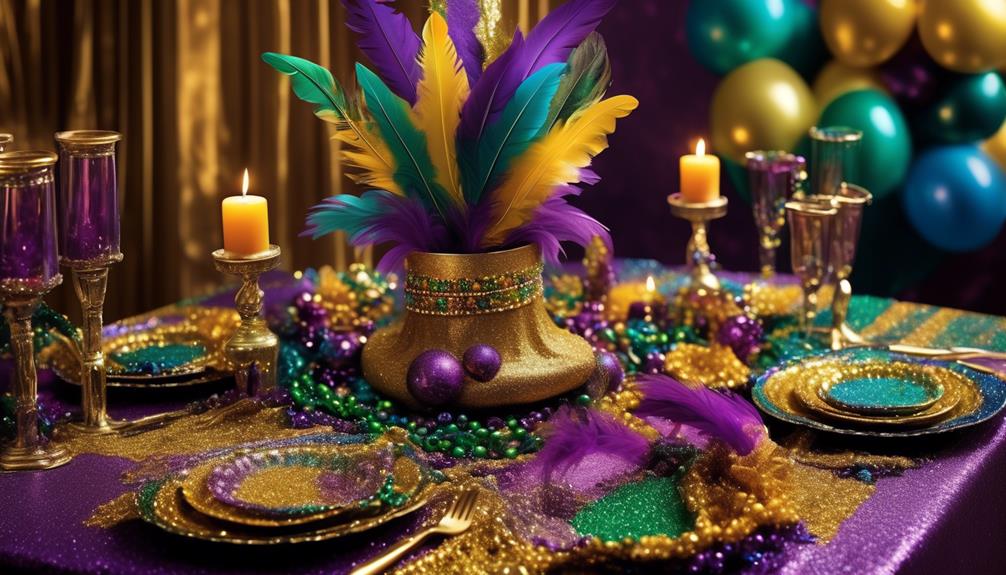
Let's talk about creating stunning glittery table centerpieces for your Mardi Gras celebration.
First, we'll cover the materials needed to bring these dazzling decorations to life.
Then, we'll provide step-by-step assembly instructions to ensure your centerpieces shine bright.
Materials Needed
We can create stunning glittery table centerpieces by gathering clear glass vases, glitter in various colors, mod podge, and paintbrushes for this craft project.
To make these beautiful centerpieces, we can use creative alternatives like recycled glass jars or repurposed wine bottles to serve as the vases. This not only adds a unique touch to the decorations but also provides budget-friendly options.
The glitter in various colors allows for personalization, and the mod podge acts as an adhesive and sealer, ensuring the glitter stays in place.
Paintbrushes are essential for applying the mod podge evenly and precisely onto the vases.
With these materials, we can bring a touch of sparkle and elegance to our Mardi Gras celebration.
Assembly Instructions
Using an assortment of clear glass vases, glitter in various colors, mod podge, and paintbrushes, we can proceed to assemble the glittery table centerpieces for our Mardi Gras celebration.
First, ensure the vases are clean and dry.
Next, apply a coat of mod podge to the outside of the vase using a paintbrush.
Then, sprinkle the glitter onto the mod podge, ensuring it covers the entire surface evenly. For a creative touch, consider mixing different colors of glitter or creating patterns.
Once the glitter is applied, let the vases dry completely.
To prevent the glitter from shedding, seal the glitter with another layer of mod podge.
Allow the vases to dry thoroughly before placing them on the tables.
These centerpieces will surely add a dazzling and festive touch to our Mardi Gras celebration.
Display and Enjoy
With our glittery table centerpieces assembled and dried, we can now showcase them as the sparkling focal point of our Mardi Gras celebration. Here's how to display and enjoy them:
- Place the glittery table centerpieces on the main dining table, ensuring they're evenly spaced to create a stunning visual impact.
- Surround the centerpieces with complementary party supplies such as colorful beads, masks, and feather boas to enhance the festive atmosphere.
- Encourage guests to snap photos with the beautiful DIY crafts and use them as conversation starters, adding an extra touch of charm to the celebration.
Homemade Jester Hats
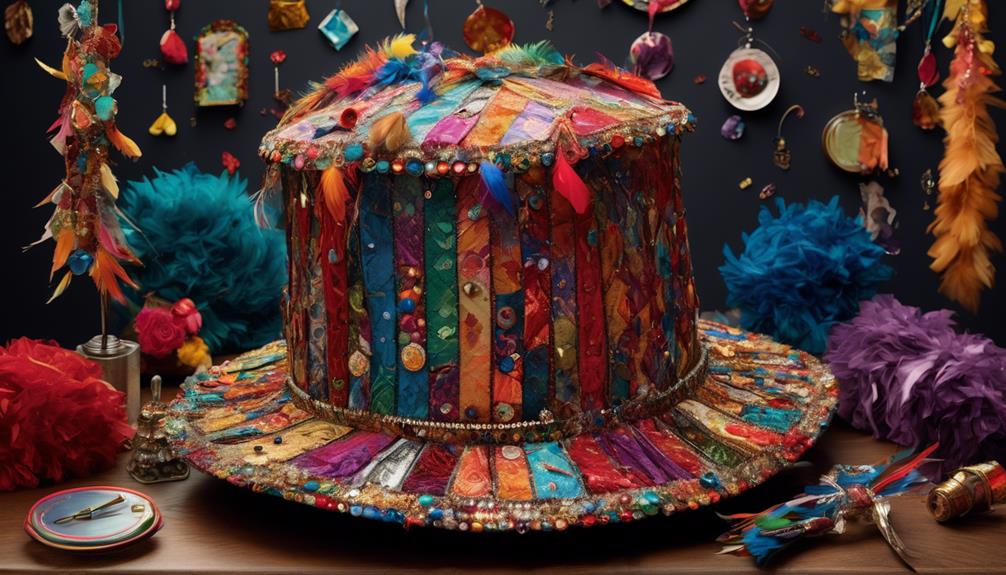
Crafting jester hats at home allows for personalized touches and creativity to shine through, adding a unique and festive flair to your Mardi Gras decorations.
Making DIY costume jester hats can be a fun and rewarding activity for both adults and kids. To start, gather supplies like colorful cardstock, glitter, bells, and elastic bands.
Cut the cardstock into long strips and staple or glue the ends together to form a band that fits around your head. Then, cut out diamond shapes from more cardstock and attach them to the band, alternating colors to create a vibrant, jester-style pattern.
Add glitter and bells for extra pizzazz. For the finishing touch, attach elastic bands to keep the hat in place.
These homemade jester hats can be great additions to your Mardi Gras party favors, and they also provide a delightful activity for guests to engage in during the celebration.
Sparkling Door Wreaths
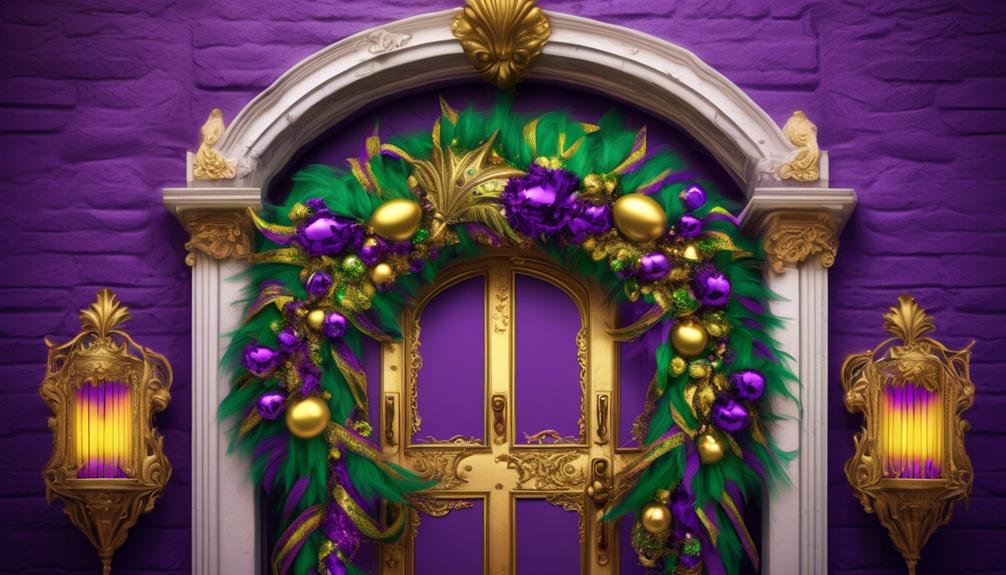
Let's create eye-catching sparkling door wreaths to add a touch of glamour and festivity to your Mardi Gras decor. Making a DIY wreath for Mardi Gras can be a fun and rewarding project. Here are some wreath decorating ideas to help you get started:
- Beaded Elegance: String colorful Mardi Gras beads around a foam or vine wreath base, securing them with hot glue. Add in some shimmering metallic beads for an extra touch of elegance.
- Feathery Flourish: Attach vibrant feathers in green, gold, and purple to the wreath using floral wire or hot glue. Layer the feathers for a lush and extravagant look.
- Glittering Accents: Sprinkle a foam or vine wreath with glitter in Mardi Gras colors. Secure the glitter with a clear sealant spray to prevent it from shedding. Then, add in some glittery Mardi Gras masks, fleur-de-lis ornaments, or decorative picks for a dazzling finish.
Creating your own sparkling door wreaths is a delightful way to showcase your creativity and bring the festive spirit of Mardi Gras to your home.
Masked Balloon Bouquets
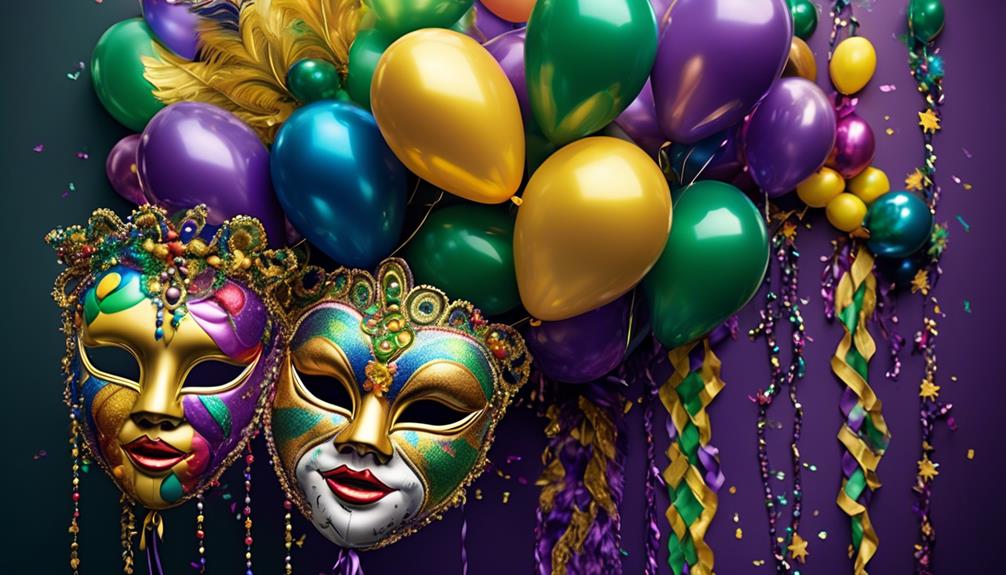
After adorning our doors with sparkling wreaths, we can enhance our Mardi Gras decor by creating vibrant and festive masked balloon bouquets. These balloon sculptures add a touch of whimsy and elegance to any masquerade party.
To craft these stunning bouquets, start by selecting an assortment of Mardi Gras colored balloons, such as purple, green, and gold. Use a variety of sizes to add visual interest. Next, inflate the balloons and tie them off, ensuring they're fully inflated for a beautiful effect.
Once you have your balloons ready, attach them to balloon sticks or lightweight wooden dowels. To create the masked effect, attach elegant masquerade masks to the top of each bouquet. Secure the masks by tying them to the sticks with colorful ribbons that complement the balloon colors. Consider adding glitter or sequins to the masks for an extra festive touch.
Arrange the finished balloon bouquets in strategic locations around your party space, such as near the entrance, the dance floor, or the food table. These vibrant and eye-catching decorations will surely delight your guests and elevate the festive atmosphere of your Mardi Gras celebration.
Jazz-Inspired Wall Decor

Exploring the rhythmic and colorful essence of jazz, we can infuse our Mardi Gras decor with captivating and vibrant wall art inspired by the soulful melodies and spirited energy of this musical genre. Jazz music, with its improvisational nature and rich history, provides a perfect backdrop for artistic inspiration as we create stunning wall decor for our Mardi Gras celebrations.
- Musical Notes Mural: Adorn your walls with a larger-than-life mural depicting swirling musical notes in vibrant Mardi Gras colors. Let the notes dance across the wall, capturing the vivacious spirit of jazz music and adding a dynamic focal point to your decor.
- Vintage Album Cover Display: Showcase vintage jazz album covers in stylish frames, creating a gallery wall that pays homage to the classic artistry of the genre. The striking visuals and evocative designs of these album covers will infuse your space with the timeless allure of jazz.
- DIY Jazz-Inspired Art: Get creative and make your own jazz-inspired art pieces using mixed media, incorporating elements like musical instruments, bold colors, and expressive brushstrokes. These unique creations will bring an authentic and personalized touch to your Mardi Gras wall decor, reflecting the improvisational and eclectic nature of jazz.
Frequently Asked Questions
Where Can I Find Affordable Mardi Gras Decorations?
We usually find affordable Mardi Gras decorations at online retailers and local stores. Online retailers offer a wide variety of Mardi Gras decorations at competitive prices, while local stores may have unique and affordable options.
For budget-friendly options, we often opt for DIY decorations. When seeking budget-friendly options, DIY decorations can be a fun and cost-effective way to add a personal touch to your Mardi Gras decor.
Are There Any Traditional Mardi Gras Symbols That I Should Include in My Decorations?
Traditional symbols like fleur-de-lis, masks, and beads are essential for DIY Mardi Gras decorations. Incorporating these symbols can add an authentic touch to your decor. Look for affordable options at craft stores or online to stay within budget.
Get creative with colors and patterns to make your decorations stand out. These symbols will bring the festive Mardi Gras spirit into your home without breaking the bank. Incorporate vibrant purples, greens, and golds—iconic Mardi Gras colors—into streamers, balloons, and table settings for an eye-catching display. You can also craft unique DIY Mardi Gras decorations like mask-themed garlands or bead-covered centerpieces to add a personal touch to your space. With a little imagination and some crafty inspiration, you can transform ordinary materials into festive, budget-friendly decor.
How Can I Incorporate Mardi Gras Decorations Into My Outdoor Space?
We can incorporate Mardi Gras decorations into our outdoor space by creating DIY Mardi Gras themed crafts. Hanging colorful banners, making festive wreaths, and crafting unique yard signs are great ways to bring the Mardi Gras spirit outside.
We can also use traditional Mardi Gras symbols like fleur-de-lis and masks to add authenticity to our outdoor decor.
What Are Some Creative Ways to Display Mardi Gras Decorations in My Home?
We've found that a creative centerpiece is a great way to showcase Mardi Gras decorations in your home.
You can make a DIY garland using colorful beads, feathers, and masks to really bring the festive spirit to any room.
Can I Make My Own Mardi Gras Decorations Using Items I Already Have at Home?
Absolutely, we can create our own Mardi Gras decorations using household items. DIY decorations aren't only budget-friendly, but they also add a personal touch to our celebrations.
By repurposing items like colorful fabric, beads, and paper, we can craft vibrant and festive décor. From handmade masks to garlands, the possibilities are endless.
Let's get creative and infuse our homes with homemade Mardi Gras spirit!
Conclusion
So, let's get ready to jazz up our Mardi Gras celebrations with these fabulous decorations!
With colorful masks, festive garlands, vibrant feather boas, glittery centerpieces, homemade jester hats, sparkling wreaths, masked balloon bouquets, and jazz-inspired wall decor, our party is sure to be a sight to behold.
Let's bring the spirit of Mardi Gras to life with these dazzling and lively decorations that will transform any space into a festive and vibrant celebration!
- About the Author
- Latest Posts
Introducing Ron, the home decor aficionado at ByRetreat, whose passion for creating beautiful and inviting spaces is at the heart of his work. With his deep knowledge of home decor and his innate sense of style, Ron brings a wealth of expertise and a keen eye for detail to the ByRetreat team.
Ron’s love for home decor goes beyond aesthetics; he understands that our surroundings play a significant role in our overall well-being and productivity. With this in mind, Ron is dedicated to transforming remote workspaces into havens of comfort, functionality, and beauty.
-

 Decor1 week ago
Decor1 week agoMaximalist Decor Explained: Embrace More Style
-

 Vetted2 weeks ago
Vetted2 weeks ago15 Best Foot Massagers for Neuropathy to Soothe Your Feet and Relieve Discomfort
-

 Vetted3 weeks ago
Vetted3 weeks ago15 Best Sports Laundry Detergents for Keeping Your Activewear Fresh and Clean
-

 Vetted3 weeks ago
Vetted3 weeks ago15 Best Tall Toilets for Seniors That Combine Comfort and Safety
-

 Vetted4 weeks ago
Vetted4 weeks ago15 Best Dish Scrubbers to Keep Your Kitchen Sparkling Clean
-

 Vetted1 day ago
Vetted1 day ago15 Best Cleaners for Fiberglass Showers to Keep Your Bathroom Sparkling Clean
-

 Decor4 weeks ago
Decor4 weeks agoWhat Is Eclectic Home Decor
-

 Vetted6 days ago
Vetted6 days ago15 Best Organic Pest Control Solutions for a Naturally Pest-Free Home
















